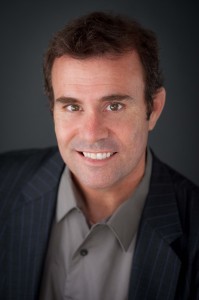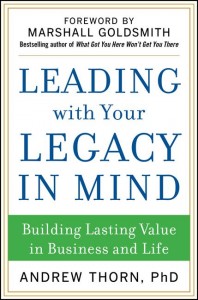Do you think about your leadership legacy?
What type of culture do you want to leave in your organization?
As a result of your leadership, what will remain long after you left?
Andrew Thorn is a business coach, consultant, and psychologist. He has recently written Leading With Your Legacy In Mind. I had the opportunity to ask him about his new book and leaving a leadership legacy.
The Importance of Legacy
Why did you decide to write about legacy?
My father passed away when he was 65 years old. I was born when he was 30, so many of the important events of my life happened 30 years after they did for him. When he died, I had an overwhelming sense that I was next in line. This caused me to think about my legacy and the impact that I was making. I asked myself if I was satisfied with my life, and the answer was no. I began to make some changes and that included writing about the process of creating a legacy.
What is Leadership?
What’s your definition of leadership?
Leadership is the act of making things better for others. When we live by this definition, all of us, regardless of our formal title or lack thereof, can engage in leading with our legacy in mind.
What is the “arc of leadership”?
The “arc of leadership” represents our own maturation as a leader. It helps us remember that life is a circular experience and that it is difficult for us to see it as a whole. When we pull out an arc, or a part of that circle, we can study it and understand it more effectively. Each arc calls us into movement and improvement.
Where To Spend Your Time
I’m interested in your view of balance. Your chapter on this subject is called “From Balance to Focus”. What does this mean?
A very lucky person, over the course of a 45 year career, will spend about 117,000 hours at work (average of 50 hours a week working), 131,000 hours sleeping (average of 8 hours a day sleeping), and 65,000 hours (average of 4 hours a day) taking care of personal responsibilities. This scenario would leave the lucky person with a little more than 50,000 hours to use however he or she wants.
Unfortunately, most of us work longer, sleep less, encumber life with unnecessary personal responsibilities and then find ourselves too tired to make our free time matter. Just by looking at the hours, we can see that there is no way to balance the number of hours between work and life. We need to work to provide for our needs. Instead of trying to balance the time, we must spend time focusing our efforts into meaningful work.
The time we spend at work is the time when we are most awake, most alert, most focused on what we want, most productive and most engaged. Once we focus on where we want to work and how we will contribute what we know we must contribute, we find ourselves full of energy at the end of the work day, which in turn means that I can use my 50,000 hours more effectively, too.
How do you coach clients to understand ‘purpose’?
I think it is important that we understand that purpose is a moving target. In other words, purpose is different during the different seasons of life. Sometimes we hang on to a purpose for too long or we let it go too soon. This is why we must be constantly evaluating what we find to be meaningful. When we connect to meaning, our purposes come into focus, too. When we can see purpose for what it is – the guiding force of why we do what we do, then we can begin to also know what to do. I use one or two questions to connect my clients to purpose: (1) Why do I want to do this? & (2) If this were my last day, would I still be willing to do what I am about to do? Once these questions are answered, there are very few doubts about purpose. I don’t want to make it any more complicated than this.
From Success to Significance
Let’s talk about one of the leadership arcs: moving from success to significance. How do you help coach someone in this area?
The legacy arc that charts the journey from success to significance helps us to remember to lead with our long-term values instead of our short-term hungers.
 I believe that success is a figment of our imagination, yet for some reason, it is a chronic obsession that plagues us all. We hope and dream for prosperity in each and every venture that we undertake. Simply put, we want to succeed at everything that we do. I realize that we do our best to keep things in perspective, but this preoccupation with success and the pressure that we feel to be successful make it easy for many of us to put the wrong things first. Whether we are willing to say it out loud or not, the real measure that most of us use is either making or having a lot of money.
I believe that success is a figment of our imagination, yet for some reason, it is a chronic obsession that plagues us all. We hope and dream for prosperity in each and every venture that we undertake. Simply put, we want to succeed at everything that we do. I realize that we do our best to keep things in perspective, but this preoccupation with success and the pressure that we feel to be successful make it easy for many of us to put the wrong things first. Whether we are willing to say it out loud or not, the real measure that most of us use is either making or having a lot of money.
Significance requires us to value the qualities more than the quantities. Significance is the quality of being important. It is not measured by how many people in the world have heard of you. It doesn’t matter how many followers you have on Twitter. Instead, it is measured by how the people closest to you have benefited from your impact. Your significance is measured by the consequences of your actions.
We create significance by stepping in and filling someone else’s need. This is what separates success from significance. Success is almost always a selfish pursuit, while significance is always gained through selfless service. Compared to significance, the bright lights of success fade quickly.
It doesn’t matter where you are working now; you have the power to create significance. This goes back to my definition of leadership. Since you are going to be at work more than anywhere else, the workplace is actually the best place for you to seek significance. You must lead by asking the question, “How can I make things better around here?”
Would you share a story of someone you worked with who changed his or her leadership style based on “legacy” coaching?
Edward was promoted because he was very capable of achieving results. When he began leading he realized that his focus on results communicated to others that he cared more about results than he did the people that were driving those results – and they were right.
Edward didn’t want to be remembered in this way, so we spent time together uncovering his true leadership style. In order to do this he had to learn to see results for what they really are: a desirable outcome that can only be achieved when the team works together and when everyone on the team gets to do what they do best.
We focused on his personal and professional aspirations, which were largely influenced by the messages found in an inspirational book that he had long treasured. As we considered the personal impact that this book had made on his life and on his professional work experiences, he found the core of his leadership identity: He wanted his people to know that they were more important than the financial successes for which they were reaching. He wanted them to be a part of a work environment that was a more inspirational environment than any other they had ever experienced. He wanted them to learn more and grow more than they ever had before. From that moment on, we made sure that every plan was aligned with this vision.
I can’t overstress the amount of time we spent thinking about how to keep our interactions simple and organic. We wanted to follow Edward’s vision of valuing each person and lifting him or her up to a new level, but we didn’t want our efforts to ever be seen as a program. It wasn’t easy, and our work required many hours of follow-up and constant vigilance in keeping the core of Edward’s leadership identity in focus. However, these efforts were rewarded in a major way. Our collective efforts helped the team, in just a short three-year period, to triple its gross revenue and net profit margins, which eventually led to Edward being promoted again to a new leadership role.
His people missed him when he moved on and often check-in to thank him for the amazing time they had together at work.
What are you reading?
I am an avid reader and that means that I am often reading many books at once. Currently, I am reading Atlas Shrugged by Ayn Rand, I Will Lead You Along: The Life of Henry B. Eyring by Henry J. Eyring and Robert Eaton, Lean In: Women, Work and the Will To Lead by Sheryl Sandberg, and The War of Art by Steven Pressfield.
Leading With Your Legacy In Mind

